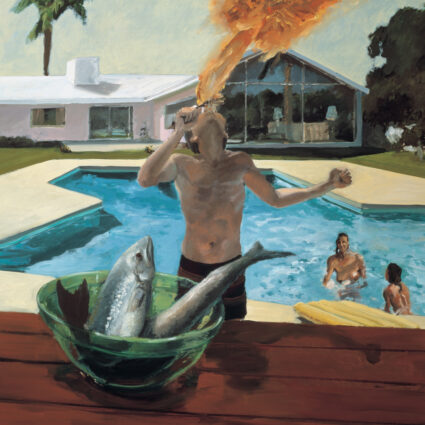Rafael Fajardo’s 8-bit video game diptych YOU MADE OUR REALITY INTO A GAME?!?! engages border issues by humanizing migrant characters with Rasquachismo, kawaii, and comic sensibilities.

Rafael Fajardo’s video game diptych, YOU MADE OUR REALITY INTO A GAME?!?!: Pixels, Politics, and Play with Rafael Fajardo, is simple and minimalist—but players shouldn’t be fooled by the 8-bit veneer. The two games engage border issues interwoven through Ciudad Juárez, Chihuahua, and El Paso, Texas.
The diptych includes two vintage-style video games, Crosser and La Migra, whose intentional semiotics, lineage of Rasquachismo, and kawaii pastiche prompt players to consider migrants’ dire circumstances. On display and playable in person through September 23, 2023, at the Southern Utah Museum of Art in Cedar City, these interactive artworks may seem like fun and games on the surface. But Fajardo unpacks the games’ lighthearted tenor with calculated judiciousness.
“A dark sense of humor where you laugh so you’re not crying all the time informs our satire,” he says.
The games started with Crosser, developed by Southwest Ensemble for Art and Technology, or SWEAT—an ad hoc name for a developer group that started as a tongue-in-cheek response to the region’s binational factory treaties circa 2000. With Fajardo at the helm, the artists took a subversive approach to how they conceptualized the game.
Viewers—or, in this case, players—participate in the artworks by playing either of the two games, which operate as installation pieces at SUMA. In homage to Frogger, Crosser sees players moving across the border as Carlos Moreno. Carlos, who starts at the bottom of the screen, must dodge obstacles such as a floating cadaver, dead cats, a bobbing tire, cars, helicopters, and “migra men” (immigration and naturalization service agents) to reach a green “Visa” sign at the top of the screen.
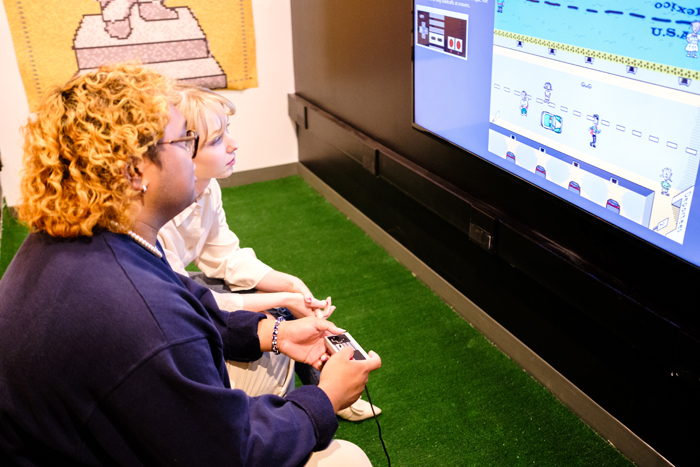
La Migra, by contrast, situates the player in the role of a migra man who patrols the border in a Ford Explorer. By toggling left and right à la in Space Invaders, the vehicle can only move forward and backward. The object of this game is to catch a quota of migrants, whose characters Fajardo lovingly refers to as “los Cacahuates” as an ode to Peanuts. The player catches migrants by flinging handcuffs up screen to detain the Cacahuates. In a reciprocal relationship with Crosser, players vie to prevent the Cacahuates from crossing without American governmental intervention.
Concerning the games’ semiotic approach, the primary tool at Fajardo’s and his team’s disposal was empathy. Character designs elicit this emotion through their simple illustrative style, which allows players to project themselves into characters to “complete the picture,” Fajardo says.
Fajardo, currently an associate professor in the Emergent Digital Practices program at the University of Denver, and a team of graduate student collaborators from either side of the border initially took inspiration from Scott McCloud’s 1993 book Understanding Comics: The Invisible Art in the fall semester of 2000 at the University of Texas at El Paso. They also adapted Japanese kawaii—Japan’s culture of cuteness—allowing the game designers to depict Carlos Moreno and La Migra’s non-player characters, or NPCs, as endearing shoe-ins for a special place in players’ hearts.
Yet an undercurrent of darkness bubbles up in La Migra. Fajardo reveals that the migra man—whom the game depicts solely inside his Ford Explorer—can strike and kill the NPC Cacahuates with his vehicle. In other games, such as those centered on violent acts, NPCs dissolve and disappear after their deaths.
“Here, the cadaver stays on the field of play and reminds the player that there are consequences to their actions and this is what they have done,” says Fajardo, who points out that an individuated death is programmed for each of the Cacahuates, which illuminates the distinct humanity of each character. Amid the attachments that players form with NPCs, their relatively harrowing deaths provoke remorse as a result.
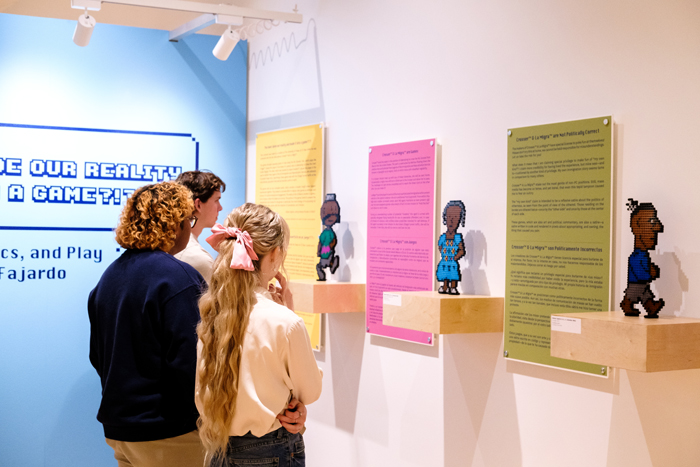
Fajardo’s first grad-student collaborators-to-be included Marco Ortega, Miguel Tarango, Francisco Ortega Grimaldo, Ryan Molloy, Carmen Escobar Martínez, and Tomás Márquez Carmona, with whom Fajardo formed SWEAT. Upon agreeing to make what would become Crosser, SWEAT faced the challenges of limited, university-supplied resources and time constraints vis-à-vis their collective game-design skill level.
But they were not dismayed.
“There’s this other aesthetic that was running in parallel in the back of my mind, and it was the Rasquache aesthetic of people who have been making beautiful and important work without having access to all of the means of production—without having access to wealth,” Fajardo says about Rasquachismo, a Chicanx art movement that upcycles leftover personal objects as an expression of lower-class struggle and pride. The Spanish-language spelling is rascuache and takes root in a Nahuatl word related to garbage.
“You would take whatever one had around and make something beautiful—and if it was garbage, then so be it.”
Hence, SWEAT developed Crosser using an abandoned Apple programming environment called Cocoa, created “to teach programming to children,” per the diptych’s artist statement.
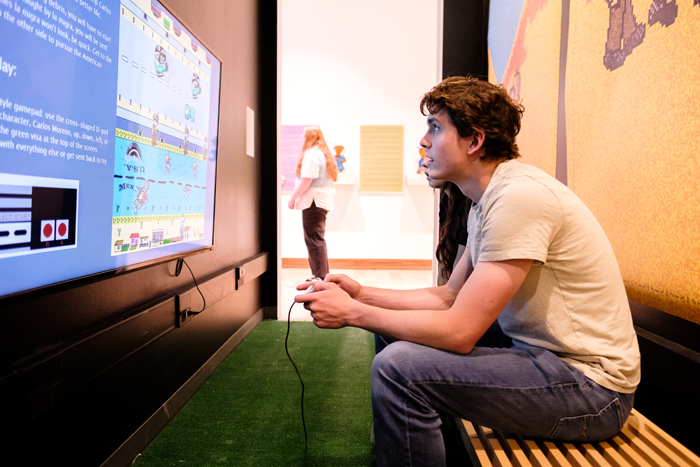
“I was convinced—and I convinced my collaborators… [if] we were actually going to make a game, it had to be in this pixelated, 2-D aesthetic that meant the near past,” Fajardo says. “We were more pixelated than that contemporary present. We were already throwback, but it wasn’t cool yet; it wasn’t nostalgic yet.”
SWEAT launched Crosser in December 2000. Fajardo developed La Migra as his professorial research project in 2001-02, and he moved on to the University of Denver in 2002. While museums and contemporary art spaces weren’t yet ready to exhibit video games, he self-published and began proliferating both games online, free of charge, and their existence via conferences and festivals across the world.
After the Denver Art Museum approached Fajardo about including him in a show called ReVisión, collaborator Chris GauthierDickey, also chair of the Department of Computer Science at the University of Denver, helped modernize the games to function on contemporary machines and today’s internet. ReVisión is now on view at the Minneapolis Institute of Art.
Meanwhile, SUMA attendees can play each game on its own forty-three-inch LCD display.
“The games are controlled through [a Nintendo Entertainment System]-style gamepad,” Fajardo explains. “This was chosen to present to players in a museum setting, many of whom might be new to games, with the simplest interface possible.”
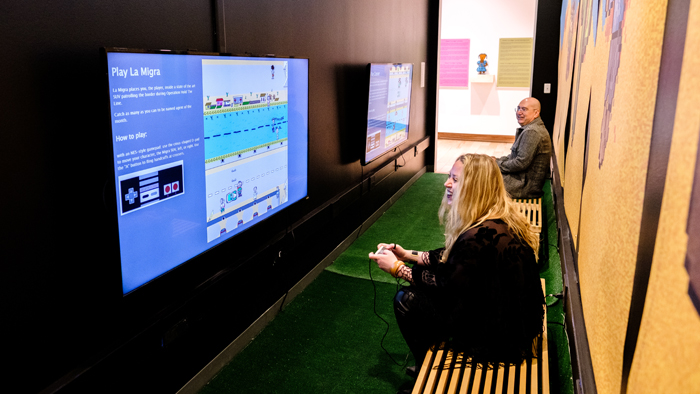
The show’s space is stylized with the games’ color palette and motifs. Additionally, Fajardo and SUMA extrapolated the games’ imagery and new visual compositions to banners hung in the space, adding an immersive touch. One banner, Femicidas—part of a series he calls Stations of the Crossing—depicts three crosses that don’t appear in the game. “Femicidas” alludes to Juárez border-wall graffiti of pink crosses on black backgrounds, which commemorates women victims of femicides in Ciudad Juárez.
“We didn’t include any depiction or mention of them in the games, but since I made the banners so much later after my own consciousness had been raised [on the issue], I thought that it would be neat to evoke, call out, uplift those memories, and have them represented in the show,” Fajardo explains.
These and other small details prove the enduring social, political, and cultural resonances of YOU MADE OUR REALITY INTO A GAME?!?!, which was guest curated by Emilie Trice. Playing these games offers an accessible inlet to keep the issue present in players’ minds. (Those who can’t make it to SUMA can play Crosser and La Migra on Fajardo’s site.)
“Having seen, understood, or been affected by policies that prevent humans from trying to seek safe havens and improve circumstances for themselves and their families—it’s a dark circumstance,” Fajardo says. “So you either cry and feel powerless or you laugh at the devil and try to take back some power.”

